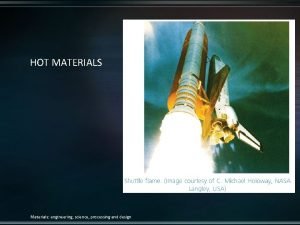Part of MATERIALS SCIENCE A Learners Guide ENGINEERING








- Slides: 8

Part of MATERIALS SCIENCE & A Learner’s Guide ENGINEERING AN INTRODUCTORY E-BOOK Anandh Subramaniam & Kantesh Balani Materials Science and Engineering (MSE) Indian Institute of Technology, Kanpur- 208016 Email: anandh@iitk. ac. in, URL: home. iitk. ac. in/~anandh http: //home. iitk. ac. in/~anandh/E-book. htm

Why are K 1 and K 2 peaks resolved at high angles? & Which ‘Line’ to use for lattice parameter calculation? q At higher Bragg angles the K 1 and K 2 lines are resolved (reason shown in the next slide) q Typically we use only the K 1 lines for the calculation of lattice parameter q The error in the calculation of lattice parameter decreases with increasing angle → hence the high angle peaks should be used for lattice parameter calculation (instead of taking an average over all peaks or taking any of the intense low angle peaks) (as shown in slides to follow)

Why are K 1 and K 2 peaks resolved at high angles? q The K 1 (Cu. Kα 1 = 1. 540598 Å) and K 2 (Cu. Kα 2 = 1. 54439 Å) lines differ slightly in wavelength. Hence, in principle two separate peaks should be seen in the diffraction pattern. q Usually, at low angles these peaks are merged (i. e. seen as a single peak) and at high angles these peaks are resolved (seen as two separate peaks). The question is why? K 1 & K 2 peaks resolved in high angle peaks (in 222 and 400 peaks this can be seen) In low angle peaks K 1 & K 2 peaks merged 400 222 311 220 111 200 q This can be understood in terms of the variation of with (as in this case is not fixed) and the graphical (Ewald sphere) construction (upcoming slides).

• 1 and 2 differ slightly in wavelength • The difference in the diffracted angle increases with an increasing angle of diffraction (for a given ). Plot of variation as above. • Hence, the 1 and 2 peaks are resolved at high angles Actually, the variation in 2 is to be seen

Which ‘Line’ to use for lattice parameter calculation? q Typically we use only the K 1 lines for the calculation of lattice parameter. And this can be done at high angles as the K 1 & K 2 lines are resolved at high angles. q The error in the calculation of lattice parameter decreases with increasing angle → hence the high angle peaks should be used for lattice parameter calculation (instead of taking an average over all peaks or taking any of the intense low angle peaks) (as shown in slides to follow).

Let us calculate the error in d spacing as a function of the angle of diffraction Fo rt he sa m e t he err o ri n. S in wi th

Error in d spacing decreases with → hence high angle peaks have to be used for lattice parameter calculation

n 2 Sin 2 ratio Index a (nm) 1 38. 52 19. 26 0. 33 0. 11 3 111 0. 40448 2 44. 76 22. 38 0. 14 4 200 0. 40457 3 65. 14 32. 57 0. 54 0. 29 8 220 0. 40471 4 78. 26 39. 13 0. 63 0. 40 11 311 0. 40480 5* 82. 47 41. 235 0. 66 0. 43 12 222 0. 40480 6* 99. 11 49. 555 0. 76 0. 58 16 400 0. 40485 7* 112. 03 56. 015 0. 83 0. 69 19 331 0. 40491 8* 116. 60 58. 3 0. 85 0. 72 20 420 0. 40491 9* 137. 47 68. 735 0. 93 0. 87 24 422 0. 40494 * 1 , 2 peaks are resolved ( 1 peaks are listed) Decreasing error Determination of Lattice parameter from 2 versus Intensity Data Others methods exist for precise lattice parameter measurement (than just taking a single value)!















